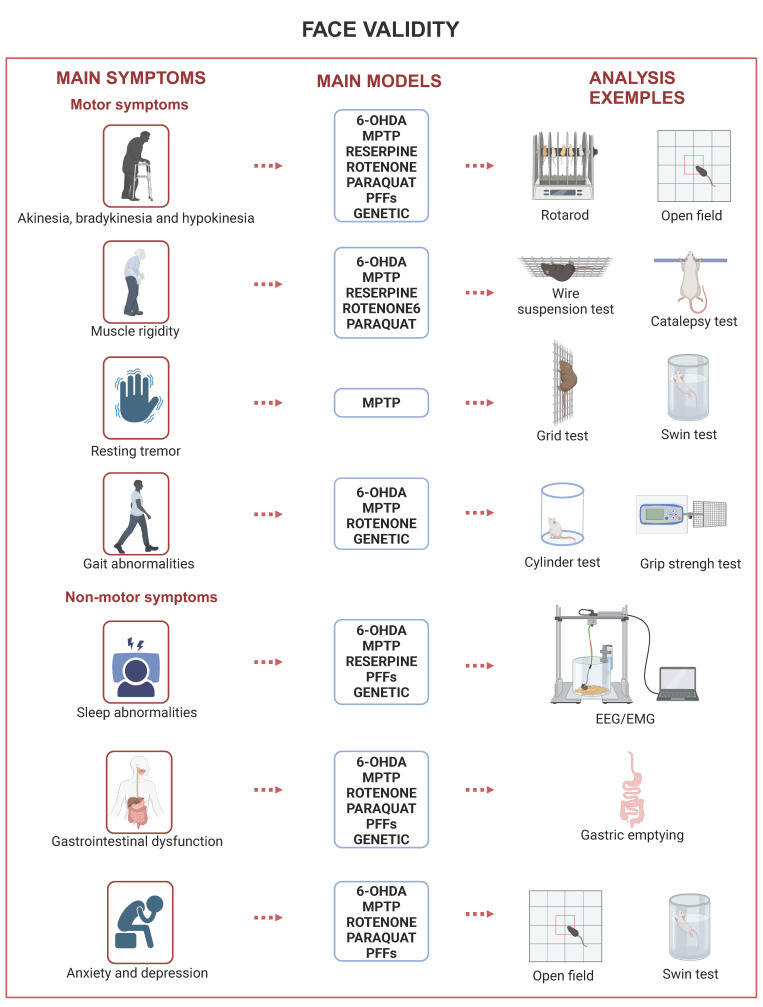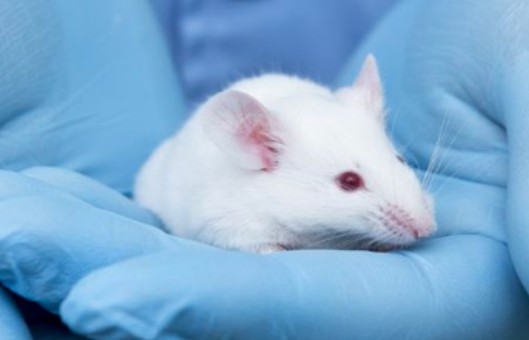Face Validity of Parkinson's Disease Rodent Models
International Journal of Molecular Sciences. 2024 Aug 17; 25 (16): 8971.
Authors: Guimarães RP, Resende MCS, Tavares MM, Belardinelli de Azevedo C, Ruiz MCM, Mortari MR.
INTRODUCTION
Parkinson's disease (PD) is the second most common neurodegenerative disease globally. Current drugs only alleviate symptoms without halting disease progression, making rodent models essential for researching new therapies and understanding the disease better. This form of analysis was meant to make tracking behavior changes more objective and systematic. In this regard, the assessment of a set of observations should be impartial in the sense that independent evaluators should reach the same objective conclusions. Therefore, the behavior of the animals analyzed had to fall under the criteria already established for it to be valid in the context of its study.
 Fig. 1 Main symptoms of PD, primary rodent models capable of simulating it, and tests used for face validity analysis.
Fig. 1 Main symptoms of PD, primary rodent models capable of simulating it, and tests used for face validity analysis.
Motor Symptoms
Akinesia, muscular rigidity, resting tremor, and gait abnormalities are some of the cardinal motor symptoms of the disease. These and other symptoms have been associated with the loss of dopaminergic neurons and the depletion of DA in the striatum. The death of neurons in the SNpc leads to a decrease in the levels of DA in the striatum, causing a loss of motor control. Most of the models developed for PD manifest one or more motor symptoms. Since they are such a cardinal symptom of PD models, many articles do not differentiate between them, simply stating that there are motor dysfunctions in the model they have worked on.
When it comes to sex differences, males tend to exhibit more motor symptoms than females. MPTP and 6-OHDA seem to cause higher motor impairment in male rats compared to females. Also, studies with reserpine have shown that female rats are more resistant to motor dysfunctions than males. In that sense, their motor impairments are delayed or prevented when compared to males.
Akinesia, bradykinesia, and hypokinesia
Akinesia can be defined as difficulty in the onset of movements and lack of spontaneous movement. Bradykinesia can be defined as slowness of movements, and hypokinesia is a reduced amplitude of movement. These symptoms often manifest themselves together and can be assessed through many of the same tests.
These symptoms can be validated through most animal models, since inducing these kinds of motor symptoms and dopaminergic loss in rodent models is one of the most thoroughly reproduced aspects of the disease. Usually, akinesia, bradykinesia, and hypokinesia can be assessed by using motor coordination tests. The rotarod test is an example, it is employed in several PD animal models because it allows for the observation of motor coordination and stamina. It assesses motor skills by placing animals on a spinning cylinder that is accelerating and measuring their latency to fall. Open field is also one of the main tests employed to assess this kind of behavior across most models. It is used in behavioral testing to track the animal's locomotion patterns and rearing since it is placed in a circular open field arena for free exploration for a specific amount of time to assess spontaneous locomotion.
Muscle rigidity
Bilateral intracerebral administration of 6-OHDA can be used to mimic muscle rigidity in rats, and the grasping test or movement-induced reflex electromyographic activity can be used for analysis. As mentioned in the akinesia section, horizontal and vertical grid tests and swim tests can be used to assess akinesia, tremor, and rigidity in MPTP. Reserpine models mimic the rigidity observed in clinical features of PD. It can be a model of transient PD symptoms with a degree of reversibility. L-DOPA can partially rescue the effect of reserpine administration. A partial recovery of nigral DA neurons occurs 30 days post-injection, rescuing motor deficits. Studies report that Paraquat exposure affects forelimb performance by causing rigidity. The wire suspension test can be employed to assess this. The test allows the mouse to grasp a horizontal wire and then evaluates its ability to pull its hanged body by flexing its forelimbs. The catalepsy test can also be used to analyze muscle rigidity in the models of MPTP, reserpine, rotenone, and paraquat.
Resting tremors
When it comes to resting tremors, there are not many models that exhibit this motor symptom. The main model that shows this symptom is the MPTP mode. For this model, horizontal and vertical grid tests and swim tests can be used to analyze akinesia, tremor, and rigidity in MPTP, as aforementioned.
Gait abnormalities
Gait abnormalities can be defined as abnormal walking patterns that deviate from normal walking or gait. They can be observed in animal models by analyzing average speed, base of support, cadence, swing speed, stride length, step cycle, duty cycle, stance, and regularity index, among other parameters. Analyzing gait parameters can also help assess other motor symptoms, such as bradykinesia, muscle rigidity, and hypokinesia. The stride length assessment may correlate to muscle rigidity and hypokinesia.
The following models have been employed to assess gait alterations: 6-OHDA, MPTP, rotenone, and genetic models. One of the main tests applied to analyze gait is the cylinder test, which is used to measure the animal's spontaneous forelimb use and its asymmetry. The rodent is put in a glass cylinder and the number of times it rears up and touches the cylinder wall is monitored. These wall touches are then scored for the right, left, or both paws. This can be used to evaluate the sensory-motor function.
Non-Motor Symptoms
PD treatment models over the years have mostly focused on striatal function and DA replacement therapy. Furthermore, their face validity was heavily based on behavioral motor symptoms. However, researchers have realized the disease is much more than that. Non-motor symptoms are being incorporated into a battery of tests when analyzing behavioral aspects of PD. Therefore, giving PD models more complexity through face validity.
As for non-motor symptoms, depression anxiety, sleep abnormalities, and gastrointestinal (GI) dysfunction are the more common ones. Although they are less talked about, non-motor symptoms of PD are a big part of the disease and affect many patients. GI dysfunction affects more than 70% of PD patients, and it has been shown that it can be replicated in mouse models. Sleep abnormalities extending from night-time awakenings, sleep fragmentation, and REM sleep disorder occur in 65–95% of PD patients. Depression and anxiety affect about 40% of the population with PD. In regards to sexual differences in non-motor symptoms, some case studies have shown that women tend to have more depression and anxiety than men. Nevertheless, no study has yet been able to reproduce such behaviors in rodent models.
Non-motor symptoms are harder to incorporate in models, but they have been shown to give great depth to the research. Therefore, understanding and considering them when designing a model is crucial.
Creative Bioarray Relevant Recommendations
| Service/Product Types | Description |
| Neurological Disease Models | It is indispensable and effective to use animal disease models in experimental medical research. Animal models of neurological disease provide a convenient and reliable platform for developing new therapies and drugs for such diseases. Creative Bioarray uses animal models of different neurological diseases to provide professional drug or therapy testing and research services. |
| Parkinson's Disease Models | Creative Bioarray focuses on drug research and development services and helps customers assess the drug efficacy and study the associated pathological mechanisms of Parkinson's disease by in vivo/vitro PD model. |
RELATED PRODUCTS & SERVICES
Reference
- Guimarães RP, et al. (2024). "Construct, Face, and Predictive Validity of Parkinson's Disease Rodent Models." Int J Mol Sci. 25 (16): 8971.


